Burnden Park: 'Forgotten' football disaster recalled
- Published
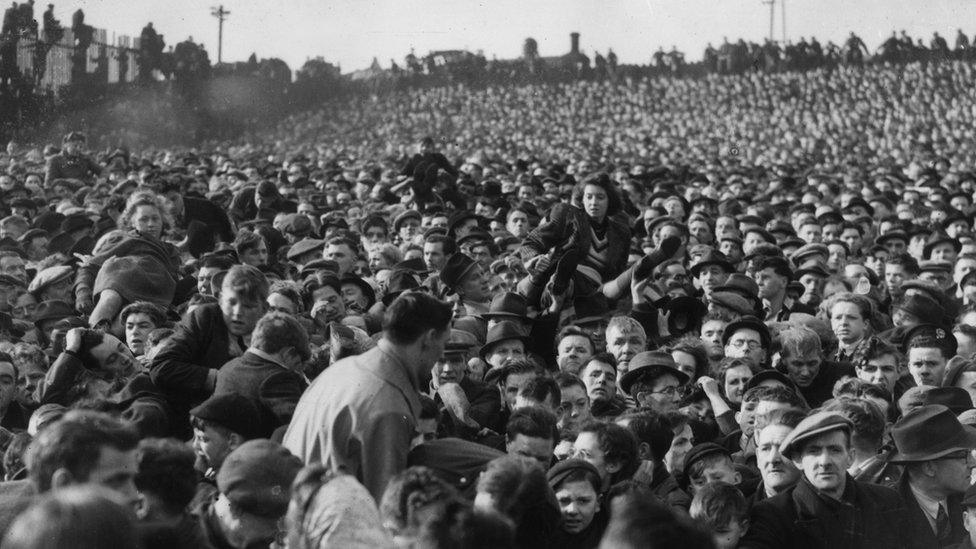
Phyllis Robb (with dark hair on the right of picture) was passed over the top of the crowd to safety
The Burnden Park stadium disaster was the worst loss of life at an English football ground before the 1980s. Thirty-three people died and around 400 were injured in a crush at an FA Cup tie 70 years ago.
Some estimates claim 85,000 people were at the FA Cup sixth-round match between Bolton Wanderers and Stoke City. However, the ground should have held at least 20,000 fewer fans.
Phyllis Robb was among them. As the crush began to be felt, she was photographed being lifted to safety and passed over the heads of the rest of the fans.
Now aged 101, she remembers it well.
"I can remember barriers breaking down and they were all rushing out - and they put me like that," she said pointing to the photograph.
She said she was not scared of the crush, adding: "I was more bothered about my father because he was still on the ground."
The disaster was the result of a perfect storm. In 1946, the FA Cup was the first competitive football played since the end of World War Two.
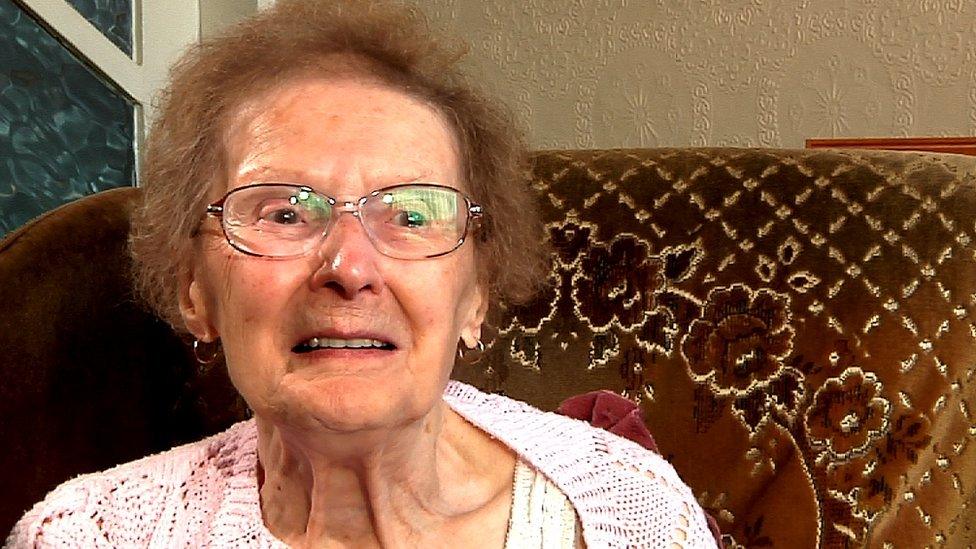
Now aged 101, Ms Robb remembers the disaster like it was yesterday
After a six-year absence of top-flight football, the fans were eager to flock to games especially as Bolton were the only team playing in Lancashire that day. An added attraction was Sir Stanley Matthews, one of the game's greatest stars, who was lining up for Stoke.
Fans from opposite ends had to use the same turnstiles because parts of the ground that had been requisitioned for wartime storage were not returned to full use.
Other supporters had to pass the same area on their way to a separate terrace creating a bottleneck.
The gates were shut 20 minutes before kick-off as fans crammed into the ground but things got worse behind a goal when a gate at the rear of the stand was opened.
Some accounts say it was forced open by fans trying to get in while others say a father picked open a lock from within to escape the crush with his son.
Whatever the truth, shortly after kick-off two barriers gave way at the Embankment End and the huge crowd fell forward crushing those in front.
Play was initially stopped but resumed with bodies laid out behind the goal.
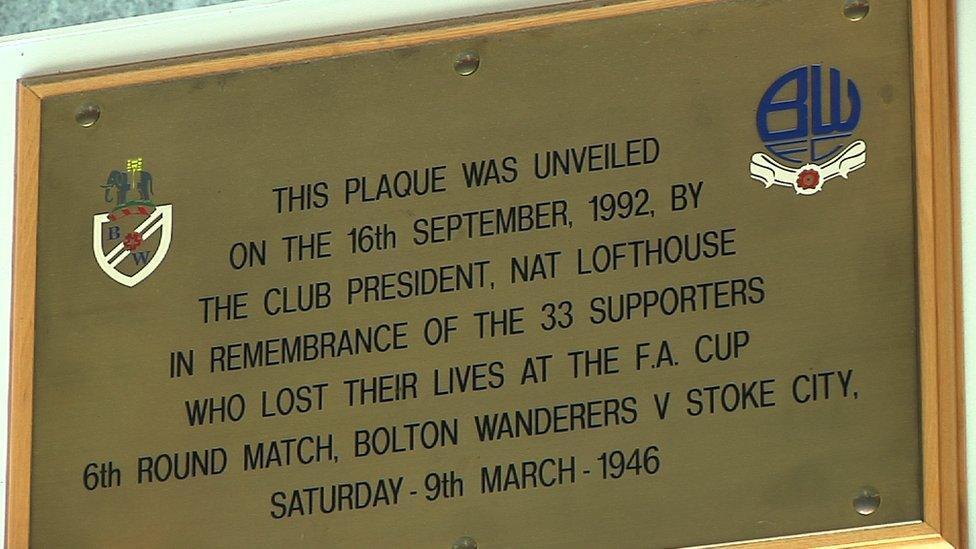
The widow of one victim campaigned for a memorial to the victims
"These days the game would be abandoned and that would be the end of it," said club historian Simon Marland.
"But I think again, communication, probably 80 per cent of the crowd in the ground at that time didn't know what was going on."
He added: "If you were stood on the other side of the ground and you saw people lying on the pitch you're probably thinking they've fainted. You wouldn't dream of people dying at a football match. "
Matthews later wrote that rumours had reached the dressing room about the growing casualty list.
"Yet it was not until I was motoring home that evening that the shadow of grim disaster descended on me like a storm cloud," he wrote.
The first footballer to be knighted donated money to a charity set up after the tragedy.
Mr Marland said it was probably a wise decision by the referee and police to continue playing.
"You can imagine all these people in the ground and all of a sudden a game of that nature where people have paid money to come in to see the game, to see Stanley Matthews is just called off with no communication why, could have caused a lot more unrest."
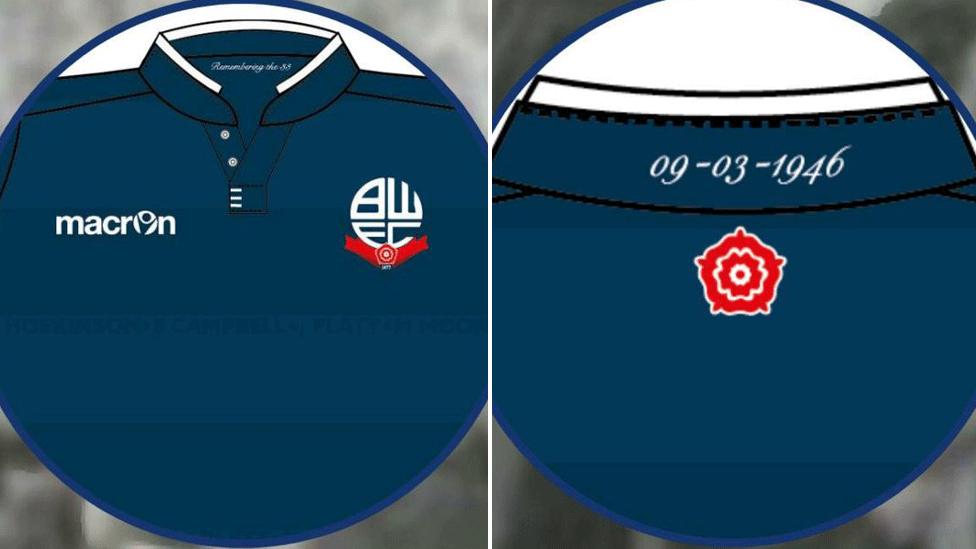
Bolton players will line up in a shirt on Saturday remembering the tragedy
Seventy years on the tragedy still seems overshadowed.
Club chaplain Phil Mason said: "The Burnden Park disaster is often seen as the forgotten disaster within the football world. So it is very important that on the 70th anniversary we mark it in a significant way."
Some people however were determined it would never be forgotten.
Among those who perished was Bill McKenzie, attending the game in the suit he received on his de-mob from the army.
"He looked wealthier than he'd ever looked in his life but when he didn't come home at night my mother wasn't concerned, she just thought he'd gone for a drink," said his daughter Sylvia Hibbert.
In later years her mother campaigned for a memorial to the victims, which was eventually placed at Burnden Park in 1992.
The stadium was demolished in 1999 and the memorial was unveiled by the late Nat Lofthouse - the club's legendary England striker - in 2000 at the Asda store built on the site.
The tragedy also left a legacy which lasted up until the deaths at Hillsborough in 1989.
Phil Mason explained: "The official report is fascinating reading - it talks about bringing in more rigorous control of crowd sizes.
"It meant that safety limits were placed for grounds of more than 25,000 capacity, turnstiles had to be able to mechanically record people entering and recommended all grounds should have internal telephone systems to improve communication in the event of a disaster."

British football's stadium tragedies
Ibrox Park Glasgow 1902 - 26 fans were killed when a wooden terrace collapsed during a Scotland v England match.
Ibrox Park 1971 - 66 Rangers supporters died by the downward force of so many supporters leaving the stadium at the same time.
Valley Parade, Bradford 1985 - 56 fans perish after debris under the stand and garbage was set alight probably by a discarded match or cigarette.
Hillsborough, Sheffield 1989 - 96 spectators die as a result of a terrace crush during the Liverpool v Nottingham Forest FA Cup Semi-final.

Mr Mason added: "The Burnden Park disaster changed history in terms of ground safety and we will always be linked to those clubs who have suffered similar plights to ourselves."
The club is recognising the dead with a week-long series of memorials.
Flags at the Macron Stadium have been at half mast since Saturday, a special programme filled with people's memories will be sold at Tuesday evening's home game against Ipswich which will be preceded by a minute's silence.
On Wednesday - the anniversary date - a pitch-side service will take place at 15:00 GMT in the stadium where a special book of remembrance will be dedicated listing the dead and placed on display in the stadium's reception.
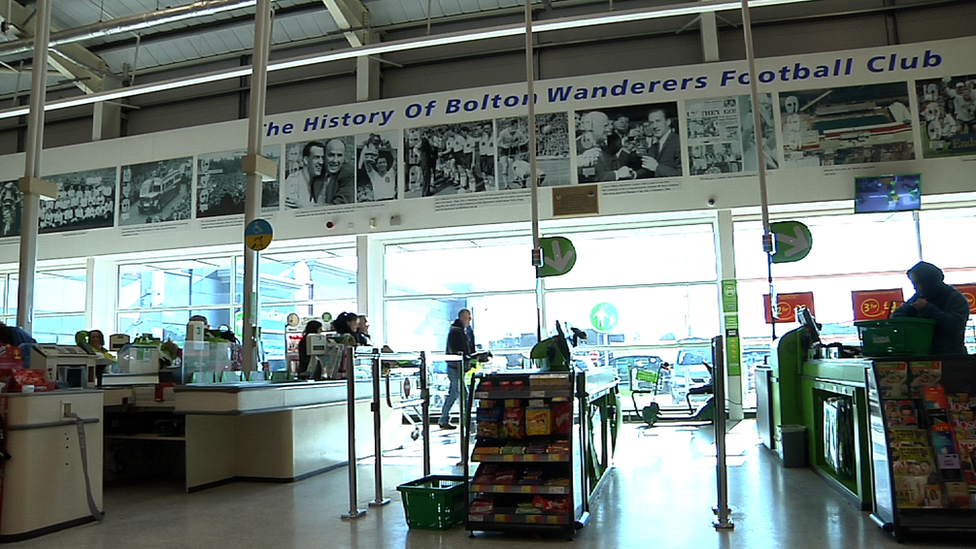
The site of the stadium is now a supermarket
On Saturday when the team play Preston North End at home players will wear a special third shirt emblazoned with 33 names of the dead. Money raised from the sale of 1,000 of these replica shirts is presented to a young person's charity.
Learn more about the disaster on BBC Inside Out North West on BBC One at 19:30 GMT.
- Published6 March 2016
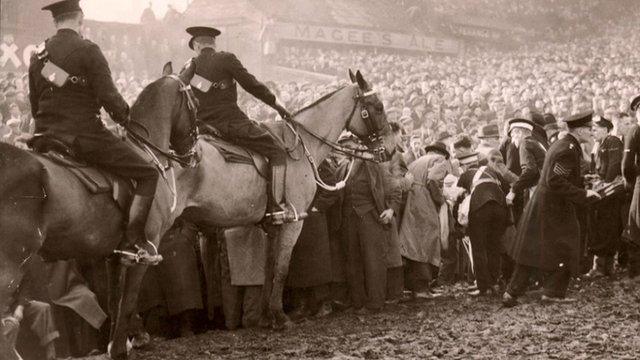
- Published20 February 2016

- Published9 March 2011